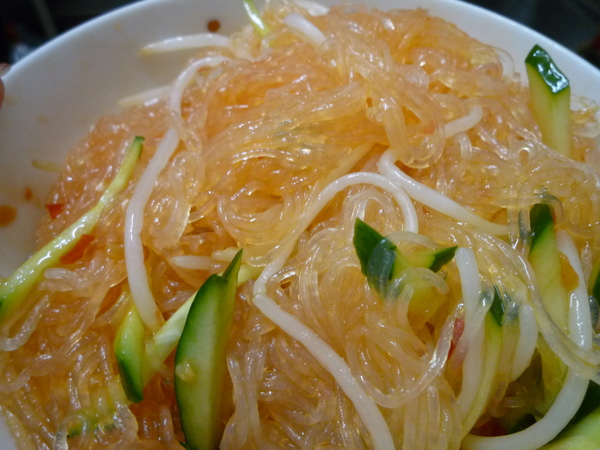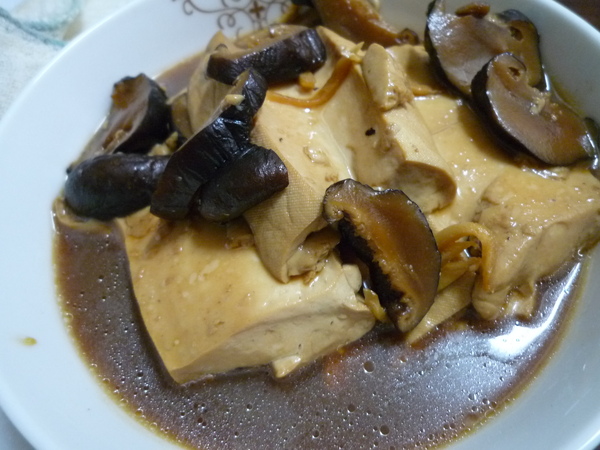

 字體:小 中 大
字體:小 中 大 |
|
|
||
| 2009/12/21 02:23:40瀏覽1503|回應0|推薦10 | ||
[Updated 10/10/09 - Hot Pot City continues to give the same level of quality and service as we discussed in the original review we did here in 2007. However, the restaurant seems to have been "discovered". There are often long waits, especially for counter seating and during prime lunch hours (12-1:30pm). Weekends often fare a bit better. Service can be brisk or completely overwhelmed. You've been warned. Going at off hours seems to help.] Welcome to cold season in Portland. It seems we each have our own special medicine for cold days, possibly a certain drink, soup, or stew that we are convinced is THE cure. My sure fire remedy when I’m feeling stuffy, and a delicious one at that, is lunch at Hot Pot City. Open since 2004, and billing itself as Portland’s only Taiwanese Hot Pot Restaurant, this is a very casual, “all you can eat” type of affair, but with a distinctively traditional and healthy Chinese twist. At around $8.50 for lunch (including your choice of refillable soft drinks or tea), it is also a fantastic bargain. Located in an odd strip mall near Portland State University, Hot Pot City is easy to get to, but difficult to find. Hidden behind a tall wall and a parking lot on one side, and a mostly abandoned park on the other, it is worth the hunt. There is plenty of free parking in the lot out front and it is only one block from the streetcar and major bus routes. Just look for the big red and white sign above the door, and the steamed up windows. Hot Pot City is a cultural melting pot and a popular college student gathering place. As my friend said, “It takes balls to open an affordable ‘all you can eat’ restaurant near a university,” and it can get quite crowded during peak hours. It is usually filled with Asian and non-Asian college students, as well as little old Chinese ladies who lunch, local business folks, and other random food lovers and bargain hunters like myself. Not much effort has gone into the décor – a few potted plants, a couple of wall hangings, and that’s it. There is one wall of simple four-seat tables, a long counter for individual dining, and a buffet lined with self-service beverages, condiments, and a bounty of vegetables, meats, noodles, and other good things for your soup pot. Hot Pot is not an unknown dining concept either here or in Asia, but a new version has become popular in Taiwan; this is also the same formula used at Hot Pot City. Rather than a large communal dish meant for sharing, this style of hot pot involves individual pots and heating elements where each diner can chose his own aromatic and flavorful broth base and what to put in it. There is no fighting with your beloved over that last tasty morsel, nor will you need to guess which perfectly cooked piece simmering in the murky brew is yours. It also means you can dine alone quite easily, although you can request one of the tables for a more traditional shared family style meal. How to Eat Hot Pot Entering Hot Pot City can be a confusing vacation to another culture – how does this work? What should I order? Where should I sit? How do I eat this stuff anyway? The drill is this: sit down at the squat counter in front of one of the built-in individual heating elements and order your soup base. Now line up at the buffet, mix your chosen sauce in a little bowl, grab a plate, and go for it. Remember though, it is all you can eat, so no need to pile it up on the first run. You’ll have plenty of opportunities for seconds, thirds, or even fourths if your appetite and gullet are big enough. When your soup arrives it is a ritualistic process: watch how others do it, or ask the staff for guidance, as they will be happy to help. Put some food in the hot pot, let it cook, remembering that veggies will take less time than meat; after a while fish the cooked food out with the little wire scoop or ladle they give to each diner, put the cooked food into a holding bowl (with some broth if you wish), add new food to the pot, pick up cooked food from your bowl, dip your food in the sauce (or some diners mix it in with the cooked food), eat, and repeat. It becomes a rhythm: food goes in, food comes out, more food goes in, and eat. Easy. Once going, the hot pot bubbles and steams like a witch’s cauldron, and at times threatens to spill over the top. Staff will come by regularly to adjust the temperature on the burner and will fill up the dissolving liquid as necessary. Choose your Base Alas, there are seven distinct soup bases to choose from, and each can be customized with one of the many condiments on the buffet. There is a mild vegetarian broth, one described as meat soup with “long-boiled clear soup of bones and meats,” and more unique choices such as the Xiang-cai soup that has Chinese cilantro with preserved egg. Beware this latter option because if you are non-Asian, the server will most likely drill you to see if you really want it. He doesn’t believe most westerners will like this as it is bold and funky, and generally somewhat of an acquired taste. Spicy soup bases are labeled as such on the menu and include the Pao-cai Korean style with pickled cabbage, a fairly mild hot and sour Thai style base, and the Ma La herbal and spice soup. The Ma La is my all time favorite, and is a popular and traditional Chinese soup that has migrated over the years from the northern part of Szechuan Province to the island of Taiwan in the south. It will blast the cold right out of you with its searing Szechuan peppers and other tasty herbs. The Bountiful Buffet The self-service buffet at HPC is clean and always well stocked. Ingredients rotate so you never know what they will have, although many are standards. Little labels in Chinese and English help demystify some of the offerings. During lunch, there are bowls of paper-thin sliced beef, chicken, and pork, and sometimes lamb, and there are always thick chunks of fragrant boneless chicken thighs marinated in ginger, onion, and soy sauce, or sometimes in bright yellow curry paste instead. Seasoned meatballs are another standard, and another perennial favorite, while other “alternative” meats such as tripe and liver make occasional appearances (fear not, those are always clearly labeled). There are usually seafood offerings as well, such as cod fillets, small whole blue crabs (which are difficult to pick the meat from), prepared squid strips, or other shellfish – even “Krab” sticks. A real treat are the little golden bundles of fried wonton stuffed with ground turkey, vegetables, and seasonings. When I asked the name, the server looked at me like I was an idiot and said, “fried wonton.” Not exactly the Chinese name I was looking for, but correct. Regardless, the fried bundles mix nicely with the broth and form toothsome yet silky and delicate soup dumplings. Vegetarians and even vegans will be happy here. You can always expect at least two kinds of tofu, both cut into large 2″ cubes: a fresh soft kind, and one labeled “frozen,” which upon further research is actually what the Chinese call “thousand layer tofu” – tofu that has been freeze dried and reconstituted. It has a very non-tofu, almost bread-like texture, and it makes a wonderful dense sponge for soaking up the hot pot flavors. Vegetable options are also based on the seasons and availability at the market. Greens such as large cleaned spinach leaves, flavorful chrysanthemum stalks, and tiny crunchy pea shoots are always bright and fresh. There are raw onion slices, cilantro, broccoli florets, button mushrooms, and sometimes things like taro root, shitake mushrooms, mung bean sprouts, bitter melon rounds, and hearty half moon slices of vibrant orange squash. Pickled cabbage often makes an appearance, too. Noodle choices include thin vermicelli rice noodles and thick udon or mein type wheat noodles. A friendly diner sitting next to me once explained that the noodles are often added to the hot pot last to soak up the now concentrated flavors. Although not all diners do this, it is now my favorite way to end the meal. Something else you should know: Hot Pot City has other things not on the menu that can be ordered for a dollar or two per serving. These include all kinds of sea foods such as whole head-on shrimp, oysters, in-shell scallops, sea snails, special cuts of meat, raw egg, or traditional preserved duck egg. Which brings me to one complaint: service is attentive, but not always proactive. For example, it would be nice to know what there is outside of the menu, as this can lead to a guessing game with the server, “do you have….”. I would suggest printing up a specials sheet as a supplement to the regular menu. Lunches are $8.50, including soft drinks or tea, and plain steamed rice is served upon request. Dinners offer more choices in meats and seafood including things such as fish cakes and delectable and tender beef meatballs, but run in the $14.00 range. While dinner is still a bargain, given the ingredients and amount of food, it hardly seems worth the extra money unless you plan on eating nothing but oysters or shrimp. There are no desserts that I know of, but there is a“regular” menu of greasy standards such as Kung-Pao beef and sweet-and-sour shrimp, but these are not special. No, what's special here is the hot pot. It's a casual, inexpensive and very authentic dish that is perfectly suited for Portland's climate.
1. http://www.portlandfoodanddrink.com/2009/10/12/take-me-down-to-hot-pot-city/ 2. http://www.portlandchinesetimes.us/news/w20090703/news.php#news9 我家自助餐推夏日美食便當 煮婦放假我們去Treasure Island(我家)餐館買雞排飯和牛肉麵: (They even charged me for the to go boxes. This is absurd.) -------------------------------------------- 跟我家Buffet老闆娘建議過他們提供客人的菜色應該至少要像這樣: http://7chinahappy.net/smf/index.php?topic=2160.0 http://www.taiwanfun.com/south/chianan/dining/0612/0612BuffetsTW.htm http://073234286.travel-web.com.tw/ 另外我還特別強調這些才比較像是我想吃的菜色:
http://fionawei.pixnet.net/blog/post/26480963 -----------------------------------------------------------
---------------------------------------------- 可是,Treasure Island餐館,不管是排骨飯、雞排飯、還是魚排飯; 都沒有切。都是整塊(整片)鋪蓋在套餐飯的大碗裡。 跟老闆娘抱怨肉要切呀! 不該沒切就拿給客人吃。 結果被老闆和老闆娘回說。本來就是要沒切整塊這樣給客人吃的。 因為套餐是XX排飯。 後來第二次叫魚排飯來吃時,我才說魚排另外放個盤子。 我先生還說妳拿把刀來讓她自己切吧。 不過, 他們的套餐飯可任選兩樣菜。 尤其我選的配菜老闆娘或是女服務生都夾給我蠻多的! 但是套餐涼麵或是套餐飯並沒有附送湯或飯後甜點。 而且他們的排骨飯只做一種口味。而且不是炸的排骨飯。 好幾次去吃Buffet菜不是出太慢,就是菜色沒變化。 茶葉蛋甚至居然常常是冷掉的! 有點可喜的是: Treasure Island餐館這陣子推出火鍋套餐吃到飽料理。 (但是按盤算,不過湯頭和茶水不算錢。) 4. 林園酒家轉戰海岸城 5. 中國城 - China Town Restaurant (Be Aware: 當餐廳店老闆不在店裡的時候, 廚師上菜的速度會慢,而且菜會燒的很難看又倒胃口!) 我們曾經在我爸要回台灣的當天帶他去那邊消費。 以上敘述都發生了!我們那天吃飯時都氣炸了!越吃越少興! 還有就是他們提供的飲茶餐點雖價錢公道,但是飲茶菜色不夠豐富。)
Website: E-mail:chinatownrestaurantor@gmail.com |
||
| ( 休閒生活|美食 ) |

















